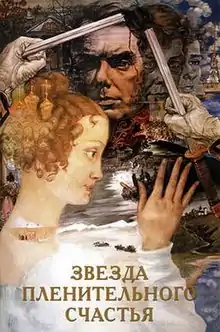The Captivating Star of Happiness
The Captivating Star of Happiness (Russian: Звезда пленительного счастья, romanized: Zvezda plenitelnogo schastya, lit. 'The Star of Fascinating Happiness') is a 1975 Soviet historical drama.[1] The title is an allusion to a line from a poem by Alexander Pushkin.[2] It is a costume drama dedicated "to the women of Russia".
| The Captivating Star of Happiness | |
|---|---|
 | |
| Directed by | Vladimir Motyl |
| Written by | Vladimir Motyl Oleg Osetinsky Mark Zakharov |
| Starring | Igor Kostolevsky Irina Kupchenko Aleksey Batalov Natalya Bondarchuk Oleg Strizhenov |
| Music by | Isaak Schwarz |
| Cinematography | Dmitriy Meshiev |
| Edited by | Ye. Sadovskaya |
Production company | |
Release date | November 11, 1975 |
Running time | 167 min. |
| Country | Soviet Union |
| Language | Russian |
Plot
The story is set in the aftermath of the Decembrist revolt against Tsar Nicholas I in 1825. The revolt is repressed, and the military officers involved confess one by one. They are sentenced to exile in Siberia and their wives face the decision as to whether or not to follow them.
Cast
- Irina Kupchenko as Princess Ekaterina Ivanovna Trubetskaya
- Aleksey Batalov as Prince Sergei Trubetskoy
- Natalya Bondarchuk as Princess Mariya Volkonskaya
- Oleg Strizhenov as Prince Sergey Volkonsky
- Eva Shikulskaya sa Polina Göbl-Annenkova, in marriage Praskovya Yegorovna
- Igor Kostolevsky as Ivan Aleksandrovich Annenkov, Decembrist, cavalergard
- Lev Ivanov as Nikolay Raevsky, a general from the cavalry (not in the credits)
- Raisa Kurkina as Sofya Alekseevna Raevskaya, the wife of NN Raevsky
- Tatyana Pankova as Anna Annenkova, the mother of IA Annenkov
- Aleksandr Porokhovshchikov as Pavel Pestel
- Victor Kostetskiy as Pyotr Kakhovsky
- Yuri Rodionov as Sergey Muravyov-Apostol
- Oleg Yankovsky as Kondraty Ryleyev
- Tatyana Fedorova as Natalia Ryleeva, the wife of KF Ryleeva
- Vasily Livanov as Emperor Nicholas I
- Innokenty Smoktunovsky as Ivan Bogdanovich Zeidler, Irkutsk Governor
- Vladislav Strzhelchik as Count Laval
- Dmitry Shilko as Count Mikhail Miloradovich, St. Petersburg Governor-General
- Igor Dmitriev as Count Lebzeltern, Austrian Envoy in St. Petersburg
- Boris Dubensky as Emperor Alexander I
- Victor Terekhov as Vasily Vasilyevich Levashov, Adjutant-General
- Vadim Makarovsky as Vosh
- Arkady Trusov as Fedor, valet Annenkov
- Mikhail Kokshenov sa Nikita, servant of Annenkov-senior
- Aleksei Kozhevnikov as Paphnutius, servant of Zeidler
Production
After making the 1970 hit film White Sun of the Desert, Motyl did not get directorial projects for five years.
When Motyl got the green light from Goskino to make a film about the Decembrists, he still had problems and had to do many rewrites because the authorities believed that the picture had too many parallels to the Soviet regime and allusions about Soviet dissidents.
Nevertheless, the screenplay was rejected. Then Motyl went to Leningrad, to the regional party committee. He handed the script to the secretary on ideology; the woman did not have time to read it and instead gave the text to her daughter who ended up adoring it. The mother called Filipp Ermash, Moscow's Minister of Cinematography and declared that "The Leningrad Regional Committee is interested in the film about the Decembrists!" Thus the script got to Lenfilm, but the budget was cut to 1.5 million rubles from the initial 3.5 million.[3][4]
The locations of the film included the Peterhof Palace and the Winter Palace.[5]